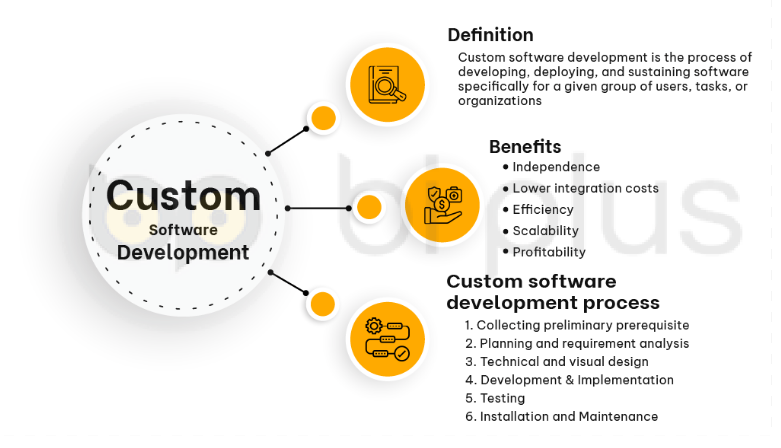
Introduction
The creation of systems, apps, and programs is all a part of the software development process. It comprises developing, testing, and maintaining software to meet the particular needs of clients or businesses. Custom software development is the process of creating software applications that are specifically tailored to the requirements of a particular business or organization. Custom software development has a number of benefits, such as increased productivity, better process control, and more efficiency. This overview will cover the principles of software development as well as the benefits of creating custom corporate software.
Definition of software development
The process of planning, building, testing, and maintaining software applications, systems, and programs is known as software development. To ensure that the software satisfies the goals and requirements of customers or enterprises, a wide range of activities, including planning, development, testing, and deployment, may be used. Software development can be done by one person, a group of people, or an entire organization. It can be used for a wide range of things, including communication, education, entertainment, and business.
Overview of custom software development
Custom software development is the process of developing software applications that are especially suited to the needs and requirements of a given firm or organization. In contrast to off-the-shelf software, which is pre-designed and may not meet the unique requirements of a corporation or business, custom software development entails a tailored strategy that ensures the software is in sync with the goals and procedures of the organization. The process of creating custom software is extensive and involves obtaining and analyzing requirements as well as design, development, testing, deployment, and maintenance. The objective is to provide software that supports ongoing business operations and growth while being effective, dependable, and scalable.
There are several industries that can benefit from bespoke software development, including e-commerce, finance, healthcare, and education. Software may be developed for internal use or to serve customers outside the firm, depending on the specific needs of the business. Ultimately, there are several benefits to developing custom software, including enhanced productivity, better process control, and increased efficiency. overview.
Importance of custom software development
Custom software development is essential for businesses that want to stay competitive and meet the unique needs of their customers or internal operations. Here are some of the key reasons why custom software development is important:
- Tailored Solutions: Custom software development provides tailored solutions that are designed to meet the specific needs of a business. This means that the software is aligned with the company’s goals, processes, and workflows, and can improve efficiency and productivity.
- Competitive Advantage: Custom software development can provide a competitive advantage by offering unique features or capabilities that are not available in off-the-shelf software. This can differentiate a business from its competitors and help it to stand out in the market.
- Scalability: Custom software can be designed to be scalable, which means it can grow and adapt to the changing needs of a business over time. This can help to future-proof the software and save the business money in the long run.
- Integration: Custom software can be integrated with existing systems and software, which can improve efficiency and reduce the need for manual data entry or duplication of effort.
- Security: Custom software development can include security features that are tailored to the specific needs of the business. This can help to protect sensitive data and prevent unauthorized access.
Overall, custom software development gives businesses the adaptability and flexibility they need to respond to shifting market dynamics and client demands while also boosting productivity and efficiency.
Software Development

Software development is the process of creating computer software programs, applications, and systems. The software development process involves a series of steps that include planning, designing, coding, testing, and maintaining software to meet specific user or business requirements.
The software development life cycle (SDLC) is a model that outlines the different stages of software development. There are many SDLC models, but some of the most popular ones include the Waterfall model, Agile methodology, and DevOps approach.
The Waterfall model is a sequential approach to software development, where each stage of the process is completed before moving on to the next. The Agile methodology, on the other hand, is an iterative approach that involves the development of software in incremental stages, with a focus on collaboration and flexibility. DevOps is a more recent approach that emphasizes collaboration and communication between developers, IT operations, and other stakeholders, with the goal of improving the speed and quality of software delivery.
The software development process involves several stages, including:
1. Requirements gathering and analysis: This involves gathering and analyzing the requirements of the software, including the features, functionality, and user interface.
2. Design: The design stage involves creating a plan or blueprint for the software, including the architecture, data models, and user interface.
3. Development: The development stage involves writing the code for the software, and using programming languages and tools to create the desired functionality.
4. Testing: The testing stage involves testing the software to ensure that it meets the requirements and is free of bugs and errors.
5. Deployment and Maintenance: The final stage involves deploying the software to users and maintaining it to ensure that it continues to meet the requirements and remains secure.
Overall, software development is a complex process that requires collaboration, attention to detail, and a focus on meeting the specific needs of users or businesses.
The software development life cycle

The software development life cycle (SDLC) is a framework that outlines the stages involved in developing software from conception to retirement. The SDLC provides a structure for software development teams to follow and ensures that software is delivered on time, within budget, and to the desired quality.
The software development life cycle typically involves the following stages:
1. Planning: This is the initial stage of the SDLC, where the software development team identifies the scope of the project, defines the requirements, and establishes a plan for how the software will be developed.
2. Analysis: In this stage, the development team analyzes the requirements and user needs to determine the software’s functionality and features.
3. Design: The design stage involves developing a plan for how the software will be developed, including creating a detailed design specification, selecting the appropriate architecture, and creating user interfaces.
4. Implementation: This is the stage where the development team writes the code and creates the software using the design specification.
5. Testing: In this stage, the software is tested to ensure that it meets the requirements and functions as intended.
6. Deployment: The deployment stage involves releasing the software to the end users.
7. Maintenance: The final stage of the SDLC is maintenance, which involves monitoring the software and making updates as needed to ensure that it remains functional and secure.
Different SDLC models, such as the Waterfall, Agile, or DevOps approaches, may have slightly different stages or ways of organizing these stages, but the basic steps involved in the software development life cycle remain the same. By following the SDLC, software development teams can create high-quality software that meets user requirements, is secure, and delivers value to the business.
Overall, software development is a complex process that requires collaboration, attention to detail, and a focus on meeting the specific needs of users or businesses.
Popular software development methodologies
The software development life cycle (SDLC) is a framework that outlines the stages involved in developing software from conception to retirement. The SDLC provides a structure for software development teams to follow and ensures that software is delivered on time, within budget, and to the desired quality.
The software development life cycle typically involves the following stages:
1. Planning: This is the initial stage of the SDLC, where the software development team identifies the scope of the project, defines the requirements, and establishes a plan for how the software will be developed.
2. Analysis: In this stage, the development team analyzes the requirements and user needs to determine the software’s functionality and features.
3. Design: The design stage involves developing a plan for how the software will be developed, including creating a detailed design specification, selecting the appropriate architecture, and creating user interfaces.
4. Implementation: This is the stage where the development team writes the code and creates the software using the design specification.
5. Testing: In this stage, the software is tested to ensure that it meets the requirements and functions as intended.
6. Deployment: The deployment stage involves releasing the software to the end users.
7. Maintenance: The final stage of the SDLC is maintenance, which involves monitoring the software and making updates as needed to ensure that it remains functional and secure.
Different SDLC models, such as the Waterfall, Agile, or DevOps approaches, may have slightly different stages or ways of organizing these stages, but the basic steps involved in the software development life cycle remain the same. By following the SDLC, software development teams can create high-quality software that meets user requirements, is secure, and delivers value to the business.
Overall, software development is a complex process that requires collaboration, attention to detail, and a focus on meeting the specific needs of users or businesses.
Agile, Waterfall, DevOps

Agile, Waterfall, and DevOps are popular software development methodologies, each with its unique approach to managing the software development process.
Agile methodology is an iterative and collaborative approach to software development that emphasizes delivering working software in short iterations, often in two to four weeks. The Agile approach requires close collaboration between the development team, customers, and stakeholders throughout the development process, with an emphasis on frequent feedback, continuous improvement, and adaptability to changing requirements.
The Waterfall methodology is a sequential approach to software development that follows a linear, step-by-step process, with each stage completed before the next stage begins. The Waterfall approach typically involves a detailed planning phase, followed by the design, implementation, testing, and deployment phases. This methodology works best when the requirements are well-defined, and there is little or no possibility of change during the development process.
DevOps is an approach to software development that combines development and operations teams to improve the speed and quality of software delivery. DevOps emphasizes collaboration, automation, and continuous delivery, enabling teams to deliver new software features and fixes more quickly and efficiently.
In summary, Agile, Waterfall, and DevOps are three popular software development methodologies that offer different approaches to managing the development process. The choice of methodology depends on the specific requirements of the project, the complexity of the software, and the goals of the development team.
Custom Software Development

The process of generating software applications that are specifically designed and created for a given organization, business, or individual is known as custom software development. Unlike off-the-shelf software, custom software is made specifically to match the demands and wants of the customer, offering a more effective and personalized solution.
The following steps are often included in the development of custom software:
1. Requirement gathering: The development team works with the customer to identify their needs, goals, and requirements for the software application.
2. Design: The design stage involves creating a plan for the software application, including the user interface, functionality, and architecture.
3. Development: In this stage, the development team writes the code and creates the software application according to the design specifications.
4. Testing: The software application is tested to ensure that it functions correctly and meets the requirements and goals of the customer.
5. Deployment: The software application is released to the customer, and the development team provides support and maintenance as needed.
Custom software development offers several advantages over off-the-shelf software, including:
1. Personalization: Custom software is tailored to meet the specific needs and requirements of the customer, providing a more personalized solution than off-the-shelf software.
2. Flexibility: Custom software can be easily modified and updated to meet changing business needs and requirements.
3. Scalability: Custom software can be designed and developed to scale as the business grows, providing a long-term solution for the customer.
4. Integration: Custom software can be integrated with other systems and applications used by the customer, providing a more seamless and efficient workflow.
Overall, custom software development is a valuable solution for businesses and organizations that require a software application that is specifically designed and developed to meet their unique needs and requirements.
Why businesses need custom software development
Businesses need custom software development for several reasons, including:
1. Improved efficiency: Custom software is designed and developed specifically for the business, allowing for streamlined workflows and increased efficiency. By automating tasks and processes, custom software can save time and reduce errors, leading to increased productivity and profitability.
2. Competitive advantage: Custom software can provide businesses with a competitive advantage by offering unique features and capabilities that are not available in off-the-shelf software. By creating software that is tailored to their specific needs, businesses can differentiate themselves from their competitors and better serve their customers.
3. Scalability: Custom software can be designed and developed to scale as the business grows, providing a long-term solution that can adapt to changing business needs and requirements.
4. Integration: Custom software can be integrated with other systems and applications used by the business, providing a more seamless and efficient workflow. This can lead to increased productivity and reduced errors.
5. Data security: Custom software can be designed with security in mind, ensuring that sensitive data is protected from unauthorized access or theft. This is especially important for businesses that handle sensitive or confidential information.
6. Cost-effectiveness: While the initial cost of custom software development may be higher than off-the-shelf software, it can be more cost-effective in the long run. Custom software can be designed to meet specific needs and requirements, reducing the need for additional software or tools that may be required with off-the-shelf software.
Custom software development provides businesses with a customized solution that can boost productivity, give them a competitive edge, scale with their growth, integrate with current systems, guarantee data security, and be long-term cost-effective.
Advantages and Disadvantages of custom software development
Advantages of custom software development:
1. Personalization: Custom software is tailored to meet the specific needs and requirements of the customer, providing a more personalized solution than off-the-shelf software.
2. Flexibility: Custom software can be easily modified and updated to meet changing business needs and requirements.
3. Scalability: Custom software can be designed and developed to scale as the business grows, providing a long-term solution for the customer.
4. Integration: Custom software can be integrated with other systems and applications used by the customer, providing a more seamless and efficient workflow.
5. Competitive advantage: Custom software can provide businesses with a competitive advantage by offering unique features and capabilities that are not available in off-the-shelf software.
6. Data security: Custom software can be designed with security in mind, ensuring that sensitive data is protected from unauthorized access or theft.
7. Cost-effectiveness: While the initial cost of custom software development may be higher than off-the-shelf software, it can be more cost-effective in the long run. Custom software can be designed to meet specific needs and requirements, reducing the need for additional software or tools that may be required with off-the-shelf software.
Disadvantages of custom software development:
1. Higher cost: Custom software development can be more expensive than off-the-shelf software, as it requires a higher level of expertise and development time.
2. Longer development time: Custom software development can take longer than off-the-shelf software, as it requires more time to design, develop, and test.
3. Risk of errors: Custom software development carries a higher risk of errors and bugs, as it is tailored to the specific needs and requirements of the customer.
4. Limited vendor support: Custom software may have limited vendor support, as it is not widely available or used by other businesses.
5. Lack of updates: Custom software may not receive regular updates or improvements, as it is not a widely used product.
Nevertheless, custom software development has benefits that frequently outweigh its drawbacks, including personalization, flexibility, scalability, integration, competitive advantage, data security, and cost-effectiveness. Yet, before agreeing to spend money on custom software development, organizations should thoroughly assess their unique demands and requirements.
Examples of Custom Software Development
- Healthcare industry
- Education industry
- Financial industry
- E-commerce industry
Challenges in Custom Software Development
- Technical challenges
- Time management challenges
- Communication challenges
- Budget challenges
Conclusion
The process of planning, creating, testing, and maintaining software is known as software development. A specialized branch of software development called “custom software development” involves making software that is specifically suited to a company’s needs and specifications. Custom software development can assist businesses by increasing productivity, obtaining a competitive edge, growing as the firm grows, integrating with current systems, assuring data security, and being long-term cost-effective. Custom software creation can, however, have drawbacks as well, including greater costs, longer development times, a larger risk of errors, fewer vendor support options, and a lack of upgrades. Before making the decision to spend money on the creation of custom software, businesses should carefully analyze their unique demands and requirements. The choice to spend money on developing bespoke software should ultimately be made based on the unique demands and requirements of the company as well as the potential advantages that custom software may provide.
Investing in custom software development can be the answer you’re searching for if you’re a business owner or manager trying to boost productivity overall, gain a competitive edge, and streamline operations. You may automate processes, lower errors, and free up your personnel to concentrate on higher-value work by developing software that is specifically designed to fit your goals and specifications. As your organization expands, custom software development also gives you the adaptability to meet shifting business needs and expectations. Additionally, security considerations can be built into custom software to safeguard your critical data from loss or illegal access. You can also get a competitive edge by investing in custom software development by providing one-of-a-kind features and functionalities that are not included in off-the-shelf software.
While developing custom software may initially cost more than buying off-the-shelf software, it often ends up being more affordable in the long term. In contrast to off-the-shelf software, which may require extra software or tools, custom software can be created to match your unique goals and specifications.
To sum up, custom software development gives organizations a customized option that can boost productivity, give them a competitive edge, scale as their business expands, interface with current systems, guarantee data security, and be long-term cost-effective. Hence, if you’re prepared to advance your company, think about funding custom software development.
